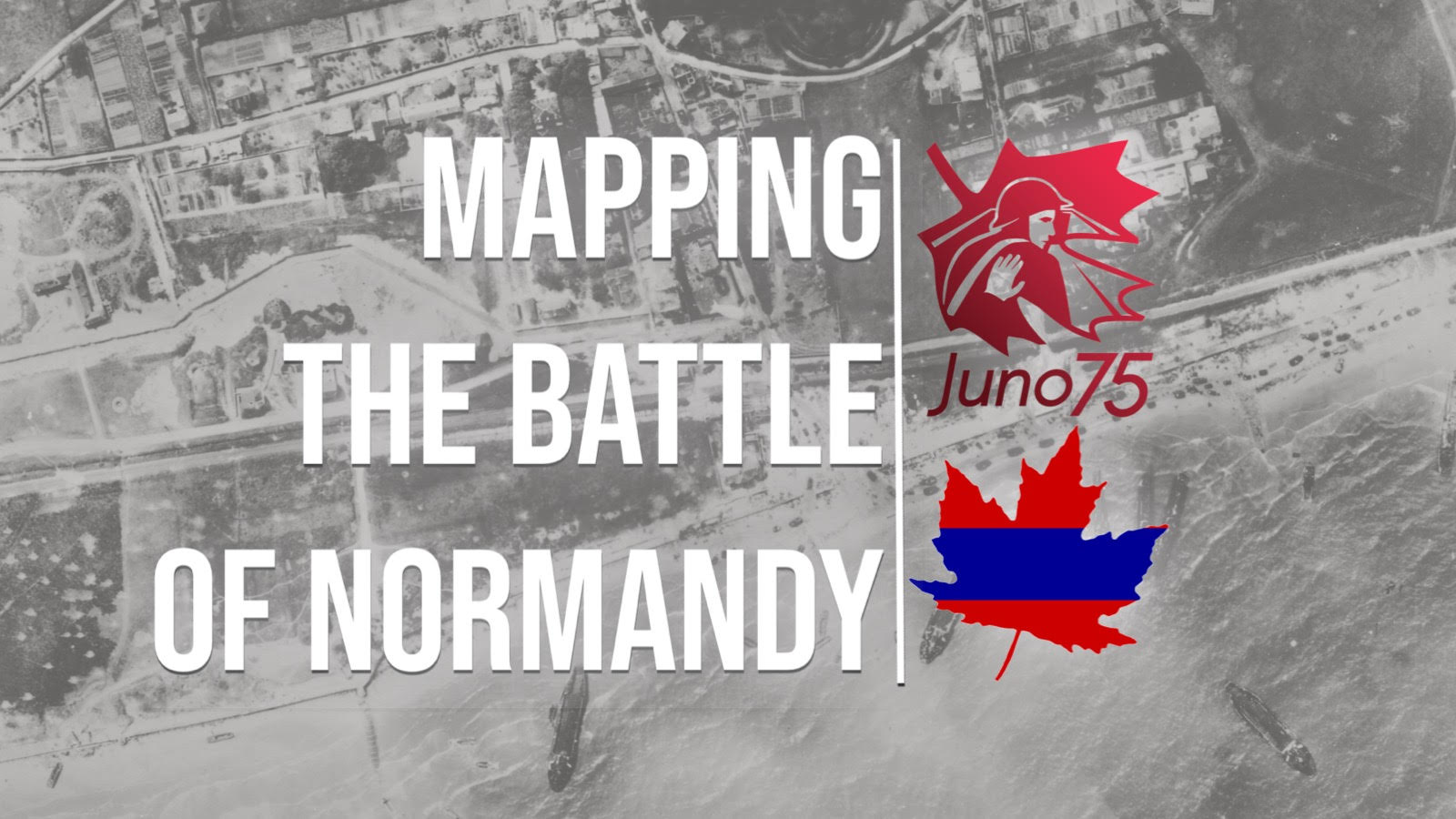Worthington Force from the Air
By Mike Bechthold Ph.D.
In Normandy during the early morning hours of 9 August 1944, a battlegroup under of the command of Lieutenant-Colonel Donald Worthington (British Columbia Regiment (BCRs) and the Algonquin Regiment) set out in the dark to capture Point 195 north of Falaise. When daylight broke, Worthington confidently reported to 4th Canadian Armoured Brigade headquarters that he was on the objective and requested immediate support to defeat the determined German attempts to dislodge him. Unbeknownst to him, his battlegroup had lost its way in the dark and ended up on a piece of high ground near Hill 140, some six and half kilometres east of its intended destination. Worthington did not realize his mistake until after he lost communications. By the end of the day his battlegroup had been destroyed at the cost of 240 casualties (85 killed, 121 wounded, and 34 captured) along with the loss of 47 tanks and numerous other armoured vehicles and half-tracks.
Sketch of Hill 140. Courtesy of the BCR museum and archive.
Historic events like the odyssey of Worthington Force are often known only through written documents created after the fact. War diaries, after-action reports, and message logs are often the building blocks for understanding the progress of a battle. These documents can be supplemented by eye witness accounts, some recorded soon after the event, but others are captured years or decades later. Like all oral testimony, these accounts must be used carefully by people trying to reconstruct the battle.
Rarely do we have photographic evidence of a battle in progress. Such photos, when carefully interpreted, can provided an unsurpassed record of the past. A great example is the photograph of Major David Currie accepting the surrender of German soldiers in St. Lambert-sur-Dives during the closing of the Falaise Pocket. Official Canadian Army historian C.P. Stacey states that this image is “as close as we are ever likely to come to a photograph of a man winning the Victoria Cross.”
Fortunately for our understanding of Worthington Force, we have images taken during the course of the battle and these photographs fundamentally change our understanding of the battle. I first discovered these aerial reconnaissance photos when I worked at the Laurier Centre for Military Strategic and Disarmament Studies at Wilfrid Laurier University. There were dozens of images taken on 9 August 1944 that captured the progress of Worthington Force as they made their way (mistakenly) to Point 140, some six-and-a-half kilometres from their intended destination of Point 195. The photos clearly show their route, their engagements, and the field which became their Alamo.
You can read my article in Canadian Military History for the full story about the loss of the battlegroup as well as the role the air photos played in helping us understand why this tragedy took place. Here I will describe a few of the remarkable air photos which capture the tragic story of Worthington Force.
Photo 1 (102-4137)
Photo 1 (102-4137)
This photograph is the “smoking gun” I used to formulate my theory on how the battlegroup lost its way. After setting out in the early morning hours of darkness and under fire, the battlegroup identified the wrong road. Instead of the Caen-Falaise highway, they followed an old Roman road, another rare straight road in Normandy. The Chemin Haussé du duc Guilliaume starts at the top left corner and extends to the centre of the photo. The tracks show that as the tanks and half tracks of the battlegroup moved south, roughly parallel to the Caen-Falaise highway (just off the photo to the left) they turned west towards the Roman road, likely pushed that way by heavy anti-tank fire originating from the outskirts of Bretteville-le-Rabet. After crossing this wide, straight road the battlegroup wheeled right and followed this road to its final position near Hill 111. In the confusion of the early morning battle, with visibility obscured by smoke, mist, and dust, this road was mistaken for the Caen–Falaise highway.
Photo 2 (102-4198)
Photo 2 (102-4198)
During their cross country journey the battlegroup encountered scattered resistance. Unbeknownst to Worthington and his men, they had crashed through a major German defensive line that was still in the process of being developed. The combination of poor visibility (due to darkness, dust, and smoke), speed, and surprise carried the Canadians through these positions. Later in the morning, as visibility improved, the German defences solidified and took a tremendous toll on “A” Squadron of the BCR which was the last in the column of march and prevented “A” and “D” Companies of the Algonquins from making it to Point 140. In this image you can see the tracks left by the journey of the battlegroup as well as numerous vehicles, many destroyed as indicated by the column of smoke rising into the sky.
Photo 3 (3-3190) and (3-3190 zoom 1)
(3-3190)
The battlegroup ended up in a rectangular field about 300 metres long by 150 metres wide where it made its final stand. Around the perimeter of the field you will see where Worthington deployed his tanks to protect their position. The smaller vehicles are the half-tracks which carried the infantry of the Algonquin Regiment. Along the hedges and in the scrub bush you can find the trenches dug by the infantry to escape the mortar and machine gun fire directed at them by the enemy.
(3-3190 zoom 1)
Worthington’s own tank and command post are visible beside the tree near the centre of the position. The small white squares and the white line in the position are air recognition panels displayed to prevent attacks by friendly aircraft. Despite the lack of two-way communications between the battlegroup and the outside world, the RAF supported Worthington throughout the day by attacking German troops who were laying siege to the Canadian position. Mistakes were made by the RAF and on more than one occasion rocket-firing Typhoons unleased their hellfire on the Canadians. Fortunately, damage was slight in these attacks.
(3-3190 zoom 2)
Photo 4 (3-3190 zoom 2)
Around 0900 hours, Worthington identified a small wood located about one kilometre south of the battlegroup position where the Germans were gathering. He despatched two troops to deal with the opposition. They were ultimately successful, but four tanks were brewed up during the engagement. In this air photo you can see the wood as well as the four burning tanks.
(3-3060)
Photo 5 (3-3060) and (3-3060 zoom 1)
The German response to their sudden discovery of the Canadian battlegroup behind their main line of resistance was quick and savage. The German commander planned to catch the Canadians in a pincher movement. Five Tiger tanks were sent from Quesnay Wood to attack Worthington from the west while a force of 15 Panthers circled around so they could attack the Canadian position from the east. This image, taken to the southwest of the field where the battlegroup was located, shows a set of tracks leading towards the battlegroup. Where the tracks stop can be seen a tank. While the resolution of this image is too grainy to definitively identify the tank, its location, tracks, and its direction of travel conclusively indicate that it is a German tank, likely one of the Panthers sent to attack the battlegroup from the east.
(3-3060 zoom 1)
Follow Mike Bechthold on twitter: @mike_bechthold
And he can be reached at mbechthold@wlu.ca
The Canadian Research and Mapping Association would like to thank Mike Bechthold for sharing his collection of aerial imagery and if you would like to know more about Worthington Force we highly recommend Lost in Normandy The Odyssey of Worthington Force, 9 August 1944.
If you are on Facebook then you will want to follow and support The British Columbia Regiment - Duke of Connaught’s Own museum society.
Click on the image below to visit our BETA webmap

